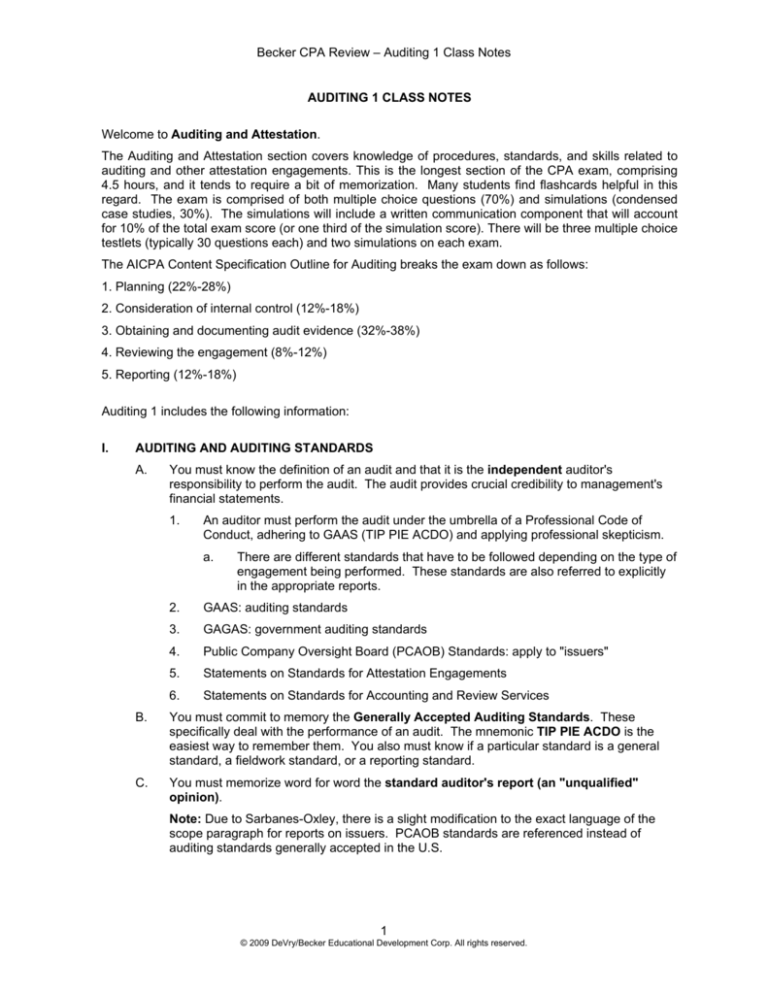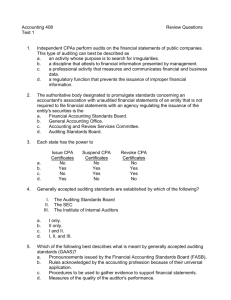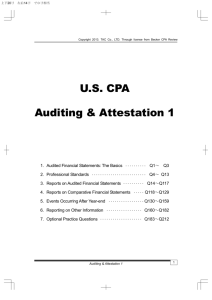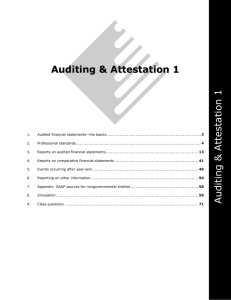
Becker CPA Review – Auditing 1 Class Notes
AUDITING 1 CLASS NOTES
Welcome to Auditing and Attestation.
The Auditing and Attestation section covers knowledge of procedures, standards, and skills related to
auditing and other attestation engagements. This is the longest section of the CPA exam, comprising
4.5 hours, and it tends to require a bit of memorization. Many students find flashcards helpful in this
regard. The exam is comprised of both multiple choice questions (70%) and simulations (condensed
case studies, 30%). The simulations will include a written communication component that will account
for 10% of the total exam score (or one third of the simulation score). There will be three multiple choice
testlets (typically 30 questions each) and two simulations on each exam.
The AICPA Content Specification Outline for Auditing breaks the exam down as follows:
1. Planning (22%-28%)
2. Consideration of internal control (12%-18%)
3. Obtaining and documenting audit evidence (32%-38%)
4. Reviewing the engagement (8%-12%)
5. Reporting (12%-18%)
Auditing 1 includes the following information:
I.
AUDITING AND AUDITING STANDARDS
A.
You must know the definition of an audit and that it is the independent auditor's
responsibility to perform the audit. The audit provides crucial credibility to management's
financial statements.
1.
An auditor must perform the audit under the umbrella of a Professional Code of
Conduct, adhering to GAAS (TIP PIE ACDO) and applying professional skepticism.
a.
There are different standards that have to be followed depending on the type of
engagement being performed. These standards are also referred to explicitly
in the appropriate reports.
2.
GAAS: auditing standards
3.
GAGAS: government auditing standards
4.
Public Company Oversight Board (PCAOB) Standards: apply to "issuers"
5.
Statements on Standards for Attestation Engagements
6.
Statements on Standards for Accounting and Review Services
B.
You must commit to memory the Generally Accepted Auditing Standards. These
specifically deal with the performance of an audit. The mnemonic TIP PIE ACDO is the
easiest way to remember them. You also must know if a particular standard is a general
standard, a fieldwork standard, or a reporting standard.
C.
You must memorize word for word the standard auditor's report (an "unqualified"
opinion).
Note: Due to Sarbanes-Oxley, there is a slight modification to the exact language of the
scope paragraph for reports on issuers. PCAOB standards are referenced instead of
auditing standards generally accepted in the U.S.
1
© 2009 DeVry/Becker Educational Development Corp. All rights reserved.
Becker CPA Review – Auditing 1 Class Notes
1.
The three paragraphs in the standard report are distinct and separate:
Introductory Paragraph – States what service is being performed and defines
management's responsibilities versus the auditor's responsibilities.
Scope Paragraph – Explains what the service entails, and refers to the correct
professional standards.
Opinion Paragraph – States the auditor's opinion regarding fair presentation of the
financial statements.
D.
You must commit to memory the different types of opinions that can be rendered in the
performance of an audit.
1.
Unqualified (clean) report, or standard opinion
2.
Modified unqualified report (adding explanatory language)
a.
Division of responsibility
b.
Necessary and justified departure from GAAP
c.
Going concern
d.
Emphasis of a matter (auditor's sole decision)
e.
Justified lack of consistency
(The other three are less frequently tested.)
3.
4.
Qualified report
a.
Qualified report due to a material GAAP departure: management failed to
follow GAAP in the preparation of the FS or required footnotes.
b.
Qualified report due to a material GAAS issue: the auditor cannot determine an
amount or a methodology, or sufficient evidence did not exist for the auditor to
be able to form a conclusion.
Disclaimer of opinion: no opinion is expressed.
E.
You must understand which situations require the unqualified report to be modified--this is
crucial to your passing the exam. The modification is solely dependent upon the
circumstances posed by the examiners.
F.
You must understand which paragraphs are modified (i.e., wording is changed), or whether
paragraphs are added or eliminated.
Note: The bulk of the language in the standard report typically remains constant, so a good
starting point is the complete memorization of that report.
G.
You must have an understanding regarding how materiality may affect the type of report
(i.e., qualified vs. adverse, or qualified vs. disclaimer). You must also understand the
situations that give rise to a modified unqualified opinion.
H.
The next items appear on the exam with less frequency than the items covered above.
1.
Unaudited Financial Statements
Be aware of the responsibilities of the auditor if his/her name is associated with
unaudited financial statements.
2.
Reports on Comparative Financial Statements
a.
The report relates to two years, which must be clearly denoted within the
report.
2
© 2009 DeVry/Becker Educational Development Corp. All rights reserved.
Becker CPA Review – Auditing 1 Class Notes
3.
b.
The examiners occasionally ask about issuing different opinions between the
two years, or about updating an opinion from the previous year.
c.
Be aware of the issues occurring when a predecessor auditor is involved in the
prior year report.
Other Items
You should have a basic understanding of the auditor's responsibility with respect to
each of the following items.
a.
Reporting on other information accompanying the FS in a client-prepared
document.
b.
Required supplementary information.
c.
Segment information.
d.
Auditor-submitted documents.
e.
Condensed FS.
f.
Selected financial data.
g.
Reports on the application of accounting principles.
I.
You must know the definition of subsequent events and whether they would be
considered Type I or Type II events. The auditor needs to differentiate between the two in
order to determine whether management's treatment was appropriate (i.e., adjustment to
the financial statements or footnote disclosure?).
J.
Be aware of the responsibilities of the auditor when facts are subsequently discovered that
existed at the balance sheet date, or when an omitted audit procedure is discovered.
1.
If management fails to make the necessary disclosures and revisions, the auditor
must advise the public.
2.
If the auditor has failed to properly perform the audit, then:
a.
The auditor should determine if another audit procedure took the place of the
omitted procedure.
b.
If the missing procedure was necessary to support the opinion and no other
procedures compensated for it, then the omitted audit procedure or an
appropriate alternative should be performed.
c.
If the auditor can no longer support the opinion, appropriate disclosure must be
made, starting with management.
K.
Know what report modifications might be necessary when reporting on FS prepared for use
in other countries.
L.
The appendix labeled "House of GAAP" provides a good understanding of the different
levels of authority and guidance that exist and the hierarchy of those concepts,
pronouncements, and literature. (A general review of this material should provide adequate
preparation for the exam.)
3
© 2009 DeVry/Becker Educational Development Corp. All rights reserved.







